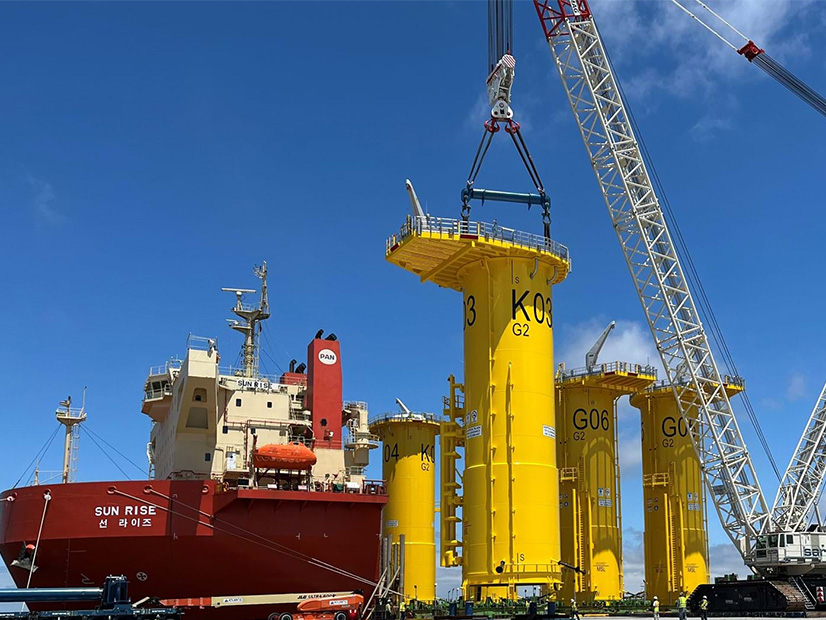
A new report charts sharp growth in the global offshore wind sector, with 2023 showing the second-highest year-over-year installed capacity jump ever.
The 2024 “Global Offshore Wind Report” by the Global Wind Energy Council (GWEC), an international trade association, indicates 75.2 GW of capacity had been installed worldwide by the end of 2023 and predicts 410 GW of additional capacity will be installed in the next 10 years — if present policy support continues and effective strategies are in place to support such growth.
Most of that growth is forecast for 2029 to 2032, GWEC said — 60 GW in 2032 alone — and much of it is expected to be driven by countries newly embracing offshore wind as a source of clean energy, such as Australia, Japan, Brazil and Poland.
The report also notes that installations are falling short of policy goals and indicates that permitting, financing, the supply chain and the grid are key to supporting or limiting factors in the growth of offshore wind.
The will to succeed is there, the report says, adding: “The priority now must be continued collaboration between industry and policymakers to overcome hurdles to rapidly scale up this crucial technology for the economic and environmental wellbeing of people and economies around the world.”
Announcing the annual report, GWEC CEO Ben Backwell said: “Installing almost 11 GW of offshore wind is the leading edge of a new wave of offshore wind growth. Policy progress — especially across the Asia-Pacific region and the Americas — has set us on course to regularly install record-breaking capacity annually and pass the 380-GW target set up by the Global Offshore Wind Alliance.”
In all, 10.8 GW of capacity was added in 2023, the report said, which was 23.7% more than was added in 2022. It was the second-highest increase ever from one year to the next, aside from the 208% increase in 2021 over 2020.
Problem Spots
The picture drawn by the report is not uniformly bright.
The U.S. wrapped up 2023 with just 42 MW of installed capacity, or 0.056% of the world total. With the completion of South Fork Wind and with continued progress on Vineyard Wind, U.S. installed capacity is much higher than at the end of 2023, but it is still less than one half of 1% of the world’s total.
A confluence of macroeconomic factors came together to slow U.S. offshore wind development in 2023, the report notes, with 7.7 GW of projects canceled outright or sidelined with canceled offtake contracts.
As a result, GWEC is now projecting 15 GW of offshore wind will be online in U.S. waters in 2030, a sharp decrease from the 25 GW it projected in last year’s edition of the report.
However, as of June 2024, “the situation is now steadily improving,” the report says, citing multiple policy changes announced by state and federal officials scrambling to get the nascent U.S. industry back on track.
Projects totaling 4.3 GW are now under construction in U.S. waters, and projects totaling 50 GW are in some stage of planning nationwide. State procurement targets announced so far total 84 GW over the next two decades.
The report identifies floating wind as another problematic area.
Floating turbines are expected to be an important part of the generation profile as hundreds of gigawatts of offshore electric generation are built because there is only so much water shallow enough for fixed-bottom turbines.
But floating wind is not evolving technologically as quickly as once expected. It is still more expensive than fixed-bottom offshore wind and the specialized equipment and infrastructure needed to build and install floating wind farms is limited or nonexistent.
Just 236 MW of floating wind was installed worldwide at the end of 2023, most of it in Norway and the U.K.
In the year since it published the 2023 report, GWEC has concluded that commercialization of floating wind is unlikely to occur until the end of this decade — three years later than it predicted in 2023 — and has reduced its 2030 projection of installed floating capacity by 22% to 8.5 GW.
The Path Forward
The report offers several suggestions for supporting the global growth of offshore wind in its 2024 report:
-
- The financing of offshore wind construction must expand, including in the Global South, where investment in the emerging markets and developing economies lags far behind mature markets and the North.
- Offshore wind can be a tool for decarbonizing industry, and the industrial sector can provide a non-government offtake mechanism for the electricity produced offshore.
- The supply chain must be built, and then it must be supported with strong volumes and steady policies. Government rules such as local content requirements and trade barriers create additional hurdles. The offshore wind industry must do its part by embracing collaboration, standardization and sustainable innovation.
- Permitting needs to proceed faster: Longer lead times raise project costs and exposure to risk.
- Expanded offshore wind development creates an opportunity for governments to pursue economic and social regeneration along coasts, if well established policies are in place and the support of communities is secured.
- The workforce needed for the campaign can be built by up-skilling and re-skilling; industry and local and federal governments should put holistic plans in place to accomplish this.
- Modern and efficient grids are the foundation on which offshore wind and other renewables stand, and a common challenge is how to achieve them. Aligning grid infrastructure development with clear regulatory frameworks will foster a resilient energy system.



